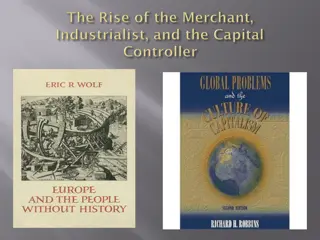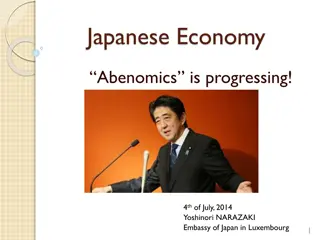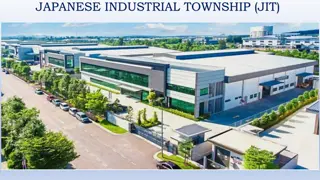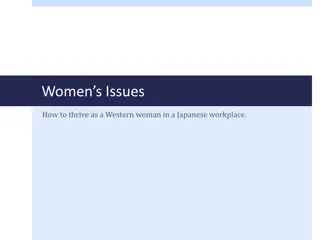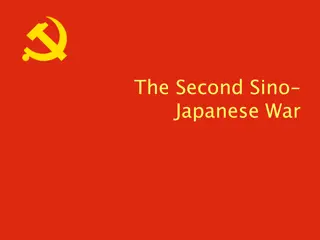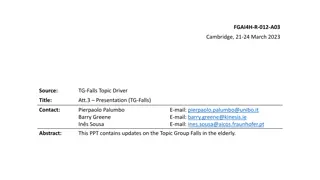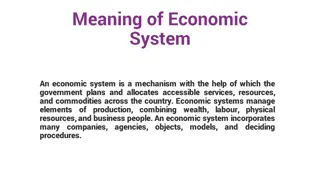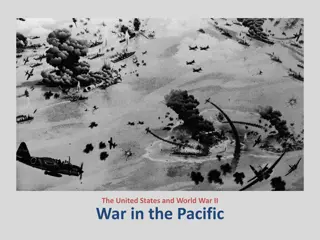The Rise and Fall of Japanese Economy in Capitalist World System
After the financial crisis of 2007 marked the beginning of the end of the postwar capitalist world system, a period of discontinuity emerged, signifying an opportunity to create a more stable economic system. By analyzing the long and super long waves of capitalist economy, particularly focusing on dynamic industries and comparative advantage, insights can be gained to shape a new economic paradigm. The historical context of long waves and dynamic industries sheds light on the evolution of different capitalist world systems, from Market Capitalism to Neoliberalism.
Download Presentation

Please find below an Image/Link to download the presentation.
The content on the website is provided AS IS for your information and personal use only. It may not be sold, licensed, or shared on other websites without obtaining consent from the author. Download presentation by click this link. If you encounter any issues during the download, it is possible that the publisher has removed the file from their server.
E N D
Presentation Transcript
The rise and fall of Japanese economy in super long waves of capitalist world system Nobuharu Yokokawa (Musashi University)
After the financial crisis of 2007 the beginning of the end of the postwar capitalist world system has started. It may be characterized as interregnum which is a period of discontinuity in social order accompanied by widespread unrest, wars, and power vacuums. However, it is a most important period to create a more stable and egalitarian world system. I follow long and super long waves of capitalist economy, and examine the rise and fall of Japanese economy to find the requirements to create such economic system.
Long waves and dynamic industries Dynamic industries are leading industries where clusters of innovations accelerate productivity growth following an S shaped logistic curve. Productivity of dynamic industries is measured by value-added per labour (VAL). VAL= the volume of product x value-added per product When a new technology spreads, value-added per product is reduced. VAL increases with the increase in productivity and eventually decreases. The VAL curve of a dynamic industry (automobile) The VAL curve of a dynamic industry (automobile) 4.5 12 VAL 4 Value added per product 10 3.5 Volume of product (right axis) 3 8 2.5 6 2 1.5 4 1 2 0.5 0 0 1910 1920 1930 1940 1950 1960 1970 1980 1990 2000 2010
Dynamic comparative advantage is the difference between VAL and wages. With increasing VAL dynamic comparative advantage increases in the first half of a long wave. Historically wages increased in proportion to average productivity. With decreasing VAL and rising wages dynamic comparative advantage eventually declines. This causes serious structural crises which destroys the existing capital accumulation regime. Dynamic comparative advantage Dynamic comparative advantage 4.5 4 3.5 3 Profits 2.5 VAL VAL 2 1.5 1 Wages 0.5 0 1910 1920 1930 1940 1950 1960 1970 1980 1990 2000 2010
There are five long waves of the rise and fall of dynamic industries corresponding to stages of capitalist world system. There are two super long waves corresponding to the rise and fall of capitalist world systems. Bureaucratic capitalism Market Capitalism Systemic crisis Systemic crisis Structural crisis Structural crisis VAL Woolen industry Cotton industry Heavy and Chemical Automobile ICT Establishment Diversification Liberalism Imperialism (1820s-1870s) (1870s-1940s) Formation Mercantilism (1750s-1810s) Establishment Welfare State (1950s-1970s) Diversification Neoliberalism (1980s-)
Market capitalism Bureaucratic capitalism The first capitalist world system, Market Capitalism, was established by Britain in the early 19th century with cotton and railway industries as the dynamic industries and foreign demand as the engine of demand growth. After the structural crisis (1870s-1890s), Imperialism (1900s-1940s) reshaped capital accumulation regime. The locus of dynamism shifted to heavy and chemical industries, and the centres of economic growth shifted from the UK to the US and Germany. The structural crisis of imperialism developed into a systemic crisis (1929- 1940s) which abolished Market Capitalism. The periods of diversification of Market Capitalism (1870s-1940s) overlapped the formation period of Bureaucratic Capitalism. Bureaucratic Capitalism was established by the US with the mass production system of machinery industries as the dynamic industry and wages as the engine of demand growth (1950s-1970s) . After the structural crisis in the 1970s, Neoliberalism (1980s-) reshaped capital accumulation regime. The locus of dynamism shifted to ICT, and the centres of economic growth shifted from the US to Asia. The structural crisis of neoliberalism may develop into a systemic crisis.
The rise and fall of Bureaucratic Capitalism The golden age (1950s and 1960s) After World War II bureaucratic capitalism successfully established the mutually reinforcing mechanism between productivity growth and demand growth with wages as the engine of demand growth. In the US the locus of dynamism shifted from heavy and chemical industries to machine and electrical industries in the 1920s and 1930s. The US mass production system in machine and electrical industries known as Fordism was established in the early 1950s. Fordism is introduced to Europe in the 1950s and 1960s.
The long-lasting high rate capital accumulation eventually destroyed its capital accumulation regime. (1) It reduced productivity growth in dynamic industries. Diffusion of technology reduced the price of products. As the result VAL was reduced. (2) It exhausted the available industrial reserve army in advanced countries. Large wage increases in the dynamic sectors spilled over into the lagging sectors. (3) Increases in wages under a declining VAL reduced the dynamic comparative advantage. And structural crisis started in the 1970s.
The neoliberal capital accumulation regime After the structural crisis of the 1970s the Anglo-American neoliberal accumulation regime reshaped the capitalist world system. The new accumulation regime shares four characteristics with Imperialism. (1) Demand constraints. Neoliberalism destroyed the link between wages and productivity growth. (2) Finance-led economy. Neoliberal financial relaxation was introduced to solve demand constraints in advanced countries. (3) Globalization. Advanced countries transferred industries which had lost their dynamic comparative advantages to countries with low wages. (4) Diversification. The centre of economic growth shifted from the USA and Europe to Asia.
Reemergence of Asia: Asias share of the world GDP was 60% in 1820. It dropped significantly in Market capitalism (15%). Asia s Reemergence started in the golden age of Bureaucratic capitalism and accelerated in neoliberalism (33%). It may return to 60% in 2050. 100% Africa 90% East Europe 80% 70% Western Europe and Ooceania 60% 50% Latin America 40% North America 30% 20% Asia 10% Madison 2007 0% 1500 1600 1700 1820 1870 1900 1950 1960 1970 1980 1990 2000
GDP shares at 2005 PPP (OECD 2014) OECD forecasts in 2050 China s share increases to 25%, that of India to 15%, while US share decreases to 18%, Euro area to 10%, and Japan to 3%. 30% China India United States Euro area (15 countries) 25% 20% 15% 10% 5% 0% 2010 2015 2020 2025 2030 2035 2040 2045 2050 2055 2060
A dynamic flying geese theory A wild-geese-flying pattern Industrialization in East Asia has been studied in the framework of Akamatsu s flying geese theory (Akamatsu 1962). The theory of dynamic comparative advantage complements Akamatsu s flying geese theory. The new theory is applicable to catch-up industrialization, leapfrogging, vertical specialization, and changes in the leaders of dynamic industries.
The new flying geese theory Industrialization in East Asia has been studied in the framework of Akamatsu s flying geese theory (Akamatsu 1962). The theory of dynamic comparative advantage complements Akamatsu s flying geese theory. The new theory is applicable to both catch- up industrialization and leapfrogging industrialization, vertical specialization, and changes in the leaders of dynamic industries.
Flying geese pattern I (Traditional) Flying geese pattern I with vertical specialization Production in Developing countries Production in Advanced Countries Demand Supply Demand Supply Production in Catch-up countries Production in Advanced Countries Export from AC Export from DC Export from CC Import Time Time (1) A platform of a dynamic industry is developed in advanced countries. (2) Production in open area such as assembly process moves to less-developed countries. VAL in open area falls accelerating falling price of the product. (3) Decreasing dynamic comparative advantage in advanced countries forces reductions in domestic production. It is characterized by reduced deployment in advanced countries and a forwarded catch-up in developing countries (1) A dynamic industry is first developed in advanced countries. (2) As the dynamic industry develops VAL increases. Production expands to achieve economies of scale, and exports begin. (3) With the further spread of production the VAL falls. Decreasing dynamic comparative advantage forces reductions in domestic production. (4) Production moves to less-developed countries with lower wages. The foreign-produced commodity is imported.
Flying geese pattern II Flying geese pattern III USA VAL Automobile Heavy and Chemical Textile Japan Europe Wages China NIES India ASEAN time The second thesis: the shift to new dynamic industries when existing dynamic comparative advantages are lost. In the new theory simultaneous industrialization of different levels of sophistication is possible. The third thesis: Development of advanced and less-advanced countries in a wild-geese-flying pattern (Akamatsu 1962). In the new theory leapfrogging (overtaking) is possible.
Japanese industrialization took flying geese pattern II. Japanese export competitiveness of textile industry peaked in the 1960s. Japan shifted its dynamic industry to heavy and chemical industries in the 1950s and the 1960s. Their export competitiveness peaked in the 1970s. In the 1970s Japan shifted its dynamic industries to mass production methods in machinery industries, such as automobiles and electrical machineries, introducing integral product architecture. Japanese dynamic industries (1965-1998) 40.0 30.0 20.0 textile heavy chemical machinery 10.0 0.0 1965 1970 1975 1980 1985 1990 1995 -10.0 -20.0
Flying geese pattern II and III in Asia (1980-1997) Export competitiveness in Textile Export competitiveness in Machinery 40 150 30 20 100 10 0 -10 80 85 90 95 97 50 -20 -30 -40 0 -50 80 85 90 95 97 -60 -50 -70 Japan China The upgrading of Japanese industries left room for less-developed East Asian countries to industrialize in the flying geese pattern. NIEs started industrialization with light industries such as textile in the 1960s. Its export competitiveness of peaked in the 1980s. NIEs promoted heavy and chemical industries and machinery industries in the 1980s. Their export competitiveness of machinery industries increased in the 1990s ASEAN 4 and then China followed NIEs. China leapfrogged ASEAN 4 both in textile and machinery in the 1990s.
New dynamic industry: is it integral or open architecture? Toyotism and integral product architecture Integral architecture. Each component is functionally incomplete and interdependent with other components functionally and/or structurally. Designs of the components tend to be specific to each variation of the total system. For each product, components have to be optimized with the other component designs by mutual adjustment (Fujimoto, 2014). The integral product architecture has strong complementarity with Japanese management system. Integral architecture, such as Toyotism, was very effective, and quality and productivity of Japanese design and production makers in automobile and other machinery improved significantly in the 1980s.
Open architecture In the 1980s, US encouraged joint R and D based on consortia of firms to develop industry- wide consensus standard. In the standardized open area implicit knowledge and knowhow were revealed and became explicit. It enabled new companies to compete with existing companies under the same conditions. Open architecture is a type of modular architecture, in which mix and match of component designs is technically and commercially feasible not only within a firm but also across firms (Fujimoto, 2014). In open area fierce price competition reduced VAL. In contrast in the protected closed area leading companies could enjoy high VAL. Breakthrough occurred in the 1990s. In the closed area US platform leaders successfully encapsulated their core technology with chipsets which is composed of a core component and other peripheral with standardized interfaces. Platform leaders supplied core chipsets to companies in emerging world, which made assembly makers in developing countries produce quality products easier (Vertical specialization), decreasing competitiveness of design and production makers in advanced countries.
Chinas compressed industrialization Chinese industrialization until the mid- 1990s was based on cheap labour and strong state ITT policies. When its exchange rate were stabilized in the mid-1990s Chinese Lewis-type industrialization reached its limits. Trade specialization in light industries such as textiles and toys peaked in the late 1980s. In the 1990s and 2000s open architecture with vertical specialization enabled China s compressed industrialization in many industries. Chinese trade specialization in sophisticated industries such as electrical and general machinery increased simultaneously from the mid- 1990s onwards thanks to open architecture with vertical specialization. Flying geese pattern II: China s dynamic industries Flying geese pattern II: China s dynamic industries 100% 90% 80% 70% 60% 50% 40% 30% 20% 10% 0% -10% 1985 1990 1995 2000 2005 2010 -20% -30% -40% -50% Textile General machinery Electrical machinery Transportation Equipment -60% -70% -80% -90%
The China-centric Asian production network Exports from China % Exports from China % Korea + Korea + Taiwan Taiwan 5 5 China s imports % China s imports % Korea + Korea + Taiwan Taiwan ASEAN ASEAN ASEAN ASEAN 5 5 Japan Japan USA USA EU27 EU27 Japan Japan USA USA EU27 EU27 1991 1991 13.1 13.1 3.4 3.4 4.8 4.8 18.5 18.5 16.7 16.7 18.1 18.1 1.7 1.7 6.1 6.1 15.6 15.6 17.5 17.5 1995 1995 16.1 16.1 4.7 4.7 4.4 4.4 21.6 21.6 14.9 14.9 24.8 24.8 9.2 9.2 8.1 8.1 13.8 13.8 18.6 18.6 2014 2014 8.0 8.0 6.1 6.1 7.2 7.2 20.9 20.9 19.7 19.7 11.0 11.0 12.6 12.6 10.0 10.0 9.2 9.2 14.5 14.5 ASEAN5=Indonesia, Malaysia, Philippines, Singapore and Thailand. The table shows that Japan s influence on the Chinese economy both in export and import peaked in the early 1990s. This was also the peak of the Japan-led Pacific Rim triangle trade regime. Open architecture with vertical specialization increased China s export competitiveness in many industries. After China became a member of the WTO (2001), its share of international trade skyrocketed. The cross-border division of work and trade in Asia has been completely rebuilt by China.
Conclusion: a new golden age? In the period of diversification of Bureaucratic Capitalism, the center of economic growth shifted from the USA to Asia. Japan introduced integral product architecture in machinery industries, and created the Pacific Rim triangle trade regime. The USA created open architecture in ICT and knowledge intensive industries as the new dynamic industries, which successfully combined platform leaders in the USA and assembly makers in developing countries in the 1990s. The new dynamic industries enabled China s compressed industrialization, and the China-centric Asian production network replaced the Japan-led Pacific Rim triangle trade regime in the 2000s.
Requirements for a new golden age Open architecture in ICT and knowledge intensive industries has possibility to increase productivity significantly with built-in software and internet. Developing its productivity requires solving demand constraints by creative destruction of the neoliberal capital accumulation regime and creating a new production-led capital accumulation regime (1) Inequality of VAL between closed and open areas must be reduced. The non-excludable and non-rivalrous character of software-led ICT and knowledge intensive industries with near zero marginal costs makes it more and more difficult to keep closed area closed. Faster price reduction increases demands. (2) Inequality in distribution of VAL between wages and profits must be reduced to make wages the engine of demand growth. (3) Stable international monetary system such as Keynes International Clearing Union must be recreated to reduce parasitic character of financialisation.




